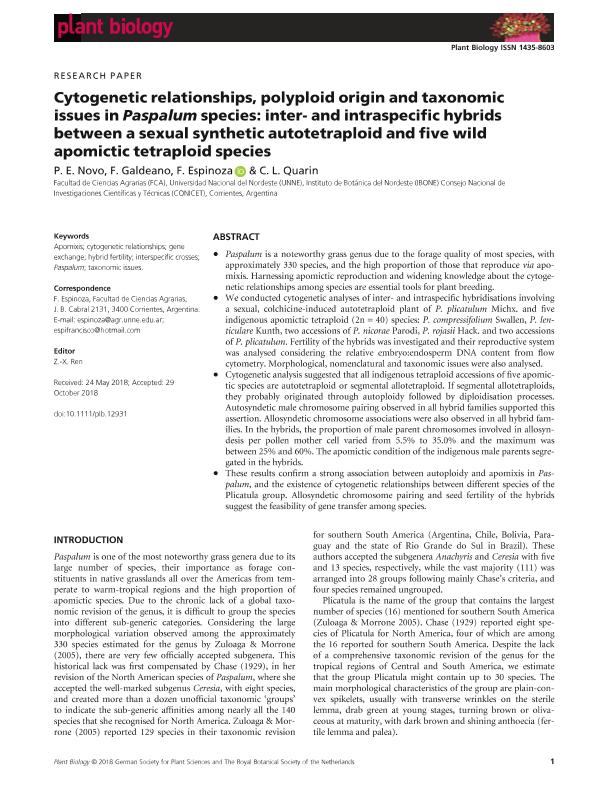Artículo
Cytogenetic relationships, polyploid origin, and taxonomic issues in Paspalum species: inter- and intraspecific hybrids between a sexual synthetic autotetraploid and five wild apomictic tetraploid species
Fecha de publicación:
11/2018
Editorial:
Wiley Blackwell Publishing, Inc
Revista:
Plant Biology
ISSN:
1435-8603
Idioma:
Inglés
Tipo de recurso:
Artículo publicado
Clasificación temática:
Resumen
Paspalum is a noteworthy grass genus due to the forage quality of most species, the total number of approximately 330 species, and the high proportion of those that reproduce via apomixis. Harnessing apomictic reproduction and widening the knowledge about the cytogenetic relationships among species are elemental tools for plant breeding.We conducted cytogenetic analyses of inter‐ and intraspecific hybridizations involving a sexual, colchicine‐induced autotetraploid plant of P.plicatulum Michx. and five indigenous apomictic tetraploid (2n = 40) species: P. compressifolium Swallen, P. lenticulare Kunth, two accessions of P. nicorae Parodi, P. rojasii Hack., and two accessions of P. plicatulum. The fertility of the hybrids was investigated and their reproductive system was analyzed considering the relative embryo:endosperm DNA content by flow cytometry. Morphological, nomenclatural and taxonomic issues were also analyzed.Cytogenetic analysis suggested that all indigenous tetraploid accessions of five apomictic species are autotetraploid or segmental allotetraploid. If segmental allotetraploids, they probably originated by autoploidy followed by diploidization processes. Autosyndetic male‐chromosome pairing observed in all hybrid families supported this assertion. Allosyndetic chromosome associations were also observed in all hybrid families. In the hybrids, the proportion of male‐parent chromosomes involved in allosyndesis per pollen mother cell varied from 5.5 to 35% and the maximum ranged between 25‐60%. The apomictic condition of the indigenous male parents segregated in the hybrids.These results confirm a strong association between autoploidy and apomixis in Paspalum, and the existence of cytogenetic relationships between different species of the Plicatula group. Allosyndetic chromosome pairing and seed fertility of the hybrids suggest the feasibility of gene transfer among species.
Palabras clave:
PASPALUM
,
GENE EXCHANGE
,
INTERSPECIFIC COSSES
,
HYBRID FERTILITY
Archivos asociados
Licencia
Identificadores
Colecciones
Articulos(IBONE)
Articulos de INST.DE BOTANICA DEL NORDESTE (I)
Articulos de INST.DE BOTANICA DEL NORDESTE (I)
Citación
Novo, Patricia Elda; Galdeano, Florencia; Espinoza, Francisco; Quarin, Camilo Luis; Cytogenetic relationships, polyploid origin, and taxonomic issues in Paspalum species: inter- and intraspecific hybrids between a sexual synthetic autotetraploid and five wild apomictic tetraploid species; Wiley Blackwell Publishing, Inc; Plant Biology; 21; 2; 11-2018; 267-277
Compartir
Altmétricas




